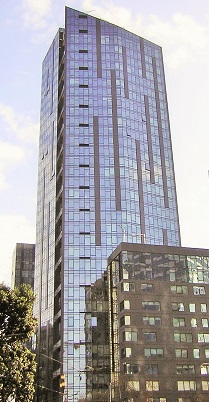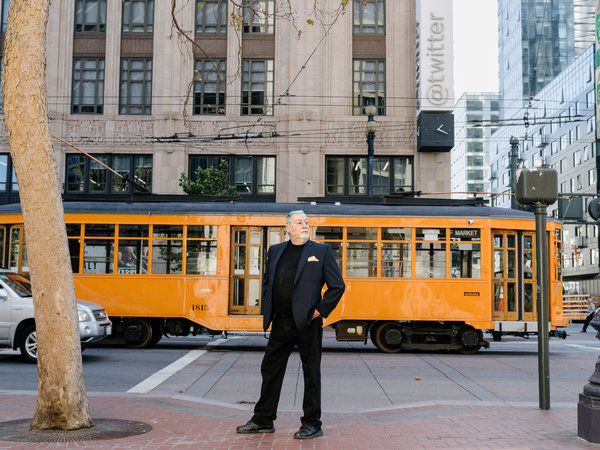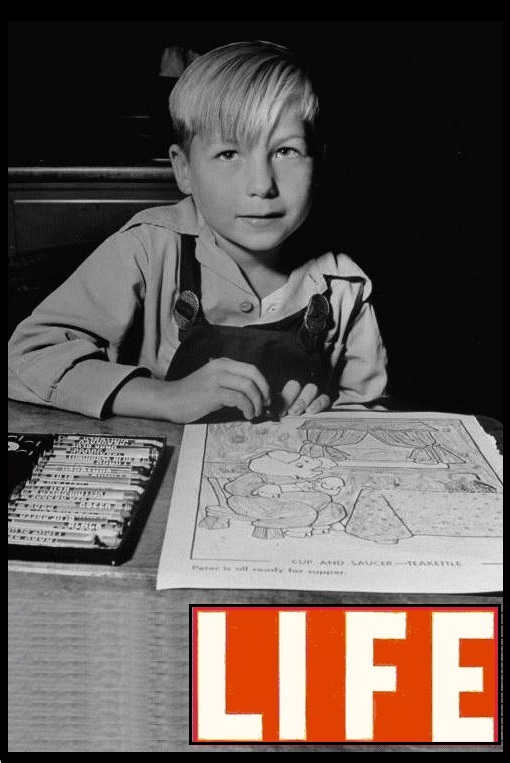I have written an overview of the Mid Market transformantion after my interview with Kim Sevenrson, from the New York Times. After this overview that includes two photos of other photo shoots over the years, is the article and photo of me in the New York Times Food Section on 2015.10.06.
Twitter is in the old Furniture Mart building as seen on the right and has been fully remodeled for tech companies.
It is across the street from where I live and is part of the Mid Market Street renovation project. This photo was taken from the balcony of my apartment on the 28th floor. There is a special tax incentive for tech companies to move into the City and the Mid Market Street area.

 I was shopping in the new high end grocery store,
Market on Market, when a reporter from The New York Times,
Kim Sevenrson, approached and asked if I knew the area and would be interested in being interviewed? I said I have lived in the City for over 52 years and across the street at Fox Plaza for 22 years. I have seen the Mid Market Street transformation with new tech companies, restaurants, coffee shops and other businesses over the last few years.
I was shopping in the new high end grocery store,
Market on Market, when a reporter from The New York Times,
Kim Sevenrson, approached and asked if I knew the area and would be interested in being interviewed? I said I have lived in the City for over 52 years and across the street at Fox Plaza for 22 years. I have seen the Mid Market Street transformation with new tech companies, restaurants, coffee shops and other businesses over the last few years.
Yammer is also located in the same building as Twitter. The Market on Market grocery store is located on the first floor on the right side of the Twitter building. Also new high end restaurants just opened on the main floor,
Dirty Water
and a French Restaurant,
Bon Marche Brasserie,
and a high end Mexican Restaurant,
Cadillac Bar & Grill.
In the next block to the east is Dolby Laboratories and that building took over three years to fully remodel. A block west is the tech company Square.
Within a block is another new restaurant, a new coffee shop and a beer hall with various types of home brews to taste.
Also new high rise apartment buildings are going up all over the City, NEMA (New Market), seen on the left, 34 and 24 stories and many others from 17 to 40 stories, all within four blocks from my apartment on the 28th floor of the Fox Plaza.
I will be meeting with
Jason Henry, the photographer for The New York Times on 2015.09.17, in case they want to include my picture in the article in the Food Section of the New York Times! Jason called me and we spent over an hour with the photo shoot! He took photos on the street looking towards the Twitter building and then came up to my apartment to take more photos of me, my living room and the view of the skyline. We shall see the results of the photo shoot and if I actually appear in The New York Times Food Section in the near future.
I have been on the cover of
Life Magazine in 1946 and featured in the
Asian Art Museum Magazine in 2013 celebrating my membership as a long time member of the museum. Now I can add a photo shoot and interview from The New York Times in 2015!
|
|
Life Magazine Photo Shoot - 1946 |
|
Asian Art Museum Photo Shoot - 2013 |
|
|
New York Times Interview & Photo Shoot - 2015.10.06 |
|
Interview with a Reporter,
Kim Sevenrson ~ 2015.09.07
|
A photo shoot with Jason Henry ~ 2015.09.17
|
A San Francisco Street Transformed by Food
SAN FRANCISCO
— For decades, as this city polished its reputation as an essential food destination, a stretch of Market Street just a short stroll from the groundbreaking Zuni Café remained stubbornly unchanged, an odd wasteland of check-cashing stores and weed dealers punctuated by the whiff of urine.
A city survey last year declared that Market Street between Seventh and 11th Streets was San Francisco’s dirtiest commercial strip. While nearby Union Square and the South of Market district blossomed, these half-dozen broad blocks remained something people rushed through on their way to more charming neighborhoods.
But in a city consumed by a tech boom that has left no inch of its roughly 47 square miles unnoticed by developers, the neighborhood now called Mid-Market is undergoing a transformation that would render it nearly unrecognizable to anyone who hasn’t braved its sidewalks for a few years.
A new culinary scene has been born seemingly overnight, the child of a three-way love affair among real estate developers, tech workers and food professionals that many say is unprecedented.
“It’s like the Wild West here, and it’s bringing these partnerships you would have never seen before,” said Traci Des Jardins, whose restaurant Jardinière helped revitalize the adjacent Hayes Valley neighborhood 18 years ago when it was still recovering from the Loma Prieta earthquake.
“Some developers are starting to see that food creates its own sort of movement in a neighborhood,” she added. “Restaurants make their own weather.”
Companies like Square, Uber and Dolby have moved in. At the epicenter is Twitter, which took over what had been a decaying Art Deco building in 2012. Early in its rehabilitation, the developer Shorenstein Properties decided to integrate food.
People living in the area are very pleased with the new businesses moving in.
Charles W. Bunjer has lived in San Francisco for 52 years and across the street from the Twitter building for 23 years. He has seen the growth from the ground up! A great time to live in the City and be part of the Mid-Market Renaissance.
At the base of the building is the Market, a gleaming 22,000-square-foot food emporium that opened in January. A shopper can buy a pound of ground grass-fed beef and some Gravenstein apples, carry out a squash blossom pizza, or eat pristine oysters at a marble-topped sushi bar.
|
Bon Marché, a French brasserie, and Dirty Water, a spot for craft cocktails and dishes like axis deer tartare and grilled quail, recently opened in the lobby, too. Other restaurants and bars continue to sprout close by.
The chef and writer Daniel Patterson, who owns the acclaimed Coi and three other Bay Area restaurants, opened Alta CA across the street from Twitter in late 2013. The restaurant, designed to feel like someone’s first grown-up apartment, is a blur of backpacks, Negronis and iPhones. It stays open until 2 a.m., serving California cuisine as viewed through an Eastern European lens.
Mr. Patterson wasn’t looking to invest in the desolate-feeling neighborhood, but Ryan Sarver, an early Twitter employee turned venture capitalist, asked him to. “He wanted us to open a restaurant because there was nothing nearby,” Mr. Patterson said, though it is worth noting that in Twitter’s free cafeteria, pigs are roasted whole and wild king salmon is served on avocado toast.
Mr. Saran said food is powerful tool to help develop the neighborhood, which is still home to some of San Francisco’s poorest residents, but is attracting thousands of tech workers with annual incomes well over $100,000. “Restaurants play as important a part as a church,” he said. “Food can bring these sides together in ways that are very important.”
But in San Francisco, where battles over gentrification have a special intensity, that quest can seem quixotic.
During an early visit to the Market, Mr. Saran recalled that he was appalled by the prices and told the managers. “I said, ‘If you want my business you need to be almost ecumenical about this,’ ” he said. “We need a little happy medium here, where there is a little salt of the earth and the chic living together, like Manhattan or New Delhi or Bombay.”
The Market has made adjustments both in pricing and in its stock, although figuring out the right mix of inventory to serve people trying to cook dinner and those looking for an interesting snack has been challenging.
“People aren’t buying canned food or staples like toilet paper,” said Ken Turner, a former chef at Zuni who recently left his position as the Market’s vice president for food to open a small restaurant in the Mission District. “They’re like, ‘Oh, look at the five different brands of coconut waters or the pickles or chocolate.’ ”
The Market tries to hire from the neighborhood, which is so close to the Tenderloin — one of the city’s first gay neighborhoods and home to waves of immigrants, musicians and the noir novelist Dashiell Hammett — that people have taken to calling it the Twitterloin.
About 15 percent of its employees are referred by the Office of Economic Workforce Development here, and another 10 percent are hired through Goodwill Industries International, said Grace Cha, the human resources manager for the company.
But jobs aren’t the only solution in a town where the riches of the tech world are rolling through poorer neighborhoods and pricing out people who work in the businesses that have sprung to serve the newcomers. Affordable health care and other services should be funded, too, Ms. Des Jardins said.
Continue reading the main story
 Mr. Patterson, the Coi chef, says there is only so much a restaurant can do to assure a balance between gentrification and social responsibility. “I definitely think restaurants have a powerful impact on the culture around them and the neighborhood,” he said, “but what can we do? No one gave me any political power.”
Mr. Patterson, the Coi chef, says there is only so much a restaurant can do to assure a balance between gentrification and social responsibility. “I definitely think restaurants have a powerful impact on the culture around them and the neighborhood,” he said, “but what can we do? No one gave me any political power.”
Charles Buntjer, 75, has lived in a rent-controlled apartment across from the Twitter building for 22 years. San Francisco has always been a boom town, he said, with neighborhoods changing as wealth and immigrants flooded in.
“There wasn’t much to lose in this neighborhood anyway,”
Mr. Buntjer
said as he shopped for groceries at the Market. “At least now I don’t have to go down to Safeway to get dinner.”
|
|
Charles Walter Buntjer
San Francisco California
|

|
Created on: 2015.09.07
Updated on: 2015.10.08
|



 I was shopping in the new high end grocery store,
Market on Market, when a reporter from The New York Times,
Kim Sevenrson, approached and asked if I knew the area and would be interested in being interviewed? I said I have lived in the City for over 52 years and across the street at Fox Plaza for 22 years. I have seen the Mid Market Street transformation with new tech companies, restaurants, coffee shops and other businesses over the last few years.
I was shopping in the new high end grocery store,
Market on Market, when a reporter from The New York Times,
Kim Sevenrson, approached and asked if I knew the area and would be interested in being interviewed? I said I have lived in the City for over 52 years and across the street at Fox Plaza for 22 years. I have seen the Mid Market Street transformation with new tech companies, restaurants, coffee shops and other businesses over the last few years.



 Mr. Patterson, the Coi chef, says there is only so much a restaurant can do to assure a balance between gentrification and social responsibility. “I definitely think restaurants have a powerful impact on the culture around them and the neighborhood,” he said, “but what can we do? No one gave me any political power.”
Mr. Patterson, the Coi chef, says there is only so much a restaurant can do to assure a balance between gentrification and social responsibility. “I definitely think restaurants have a powerful impact on the culture around them and the neighborhood,” he said, “but what can we do? No one gave me any political power.”
